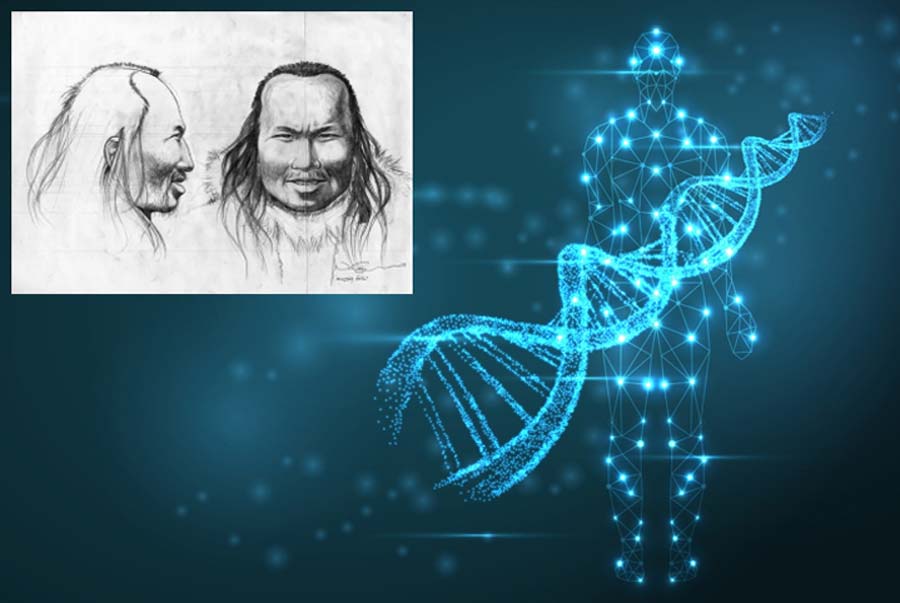Decade of DNA Analysis Reveals Astonishing Truths About Our Past
It was a little over a decade ago that the evolutionary biologist Eske Willerslev successfully applied innovative DNA analysis and decoding technology to unlock genetic secrets from the past. In that case it was a sample of 4,000-year-old hair recovered from the arctic permafrost of Greenland. This was a landmark achievement, since it was the first time a scientist had been able to sequence an entire genome belonging to someone who had lived and died in ancient times.

Just over 10 years ago, Willerslev used DNA analysis on a hair frozen in Greenland permafrost. Image shows reconstruction of a member of the extinct Saqqaq culture created using the results of this DNA analysis. (Nuka Godfredtsen)
Celebrating a Decade of Ancient DNA Analysis
In celebration of the burgeoning field of ancient DNA analysis, Professor Willerslev, who is now the director of the Lundbeck Foundation GeoGenetics Centre at the University of Copenhagen, has just published a comprehensive review of what has been discovered about the ancient genomics of the Americas over the past 10 years.
In the June 2021 edition of Nature, Willerslev and the Southern Methodist University (Texas) archaeologist David Meltzer explain how ancient DNA sequencing technology has revolutionized archaeology, anthropology, and evolutionary biology. In this article, entitled Peopling of the Americas as inferred from ancient genomics, the authors demonstrate that ancient genome recovery and DNA analysis has opened the doors to a new era of discovery, filled with fresh and exciting insights into the genetic history of humanity, including its relatives and predecessors, including the Neanderthals and the Denisovans.
- 24,000-Year-Old Boy reveals Origins of Native Americans
- Textbook Story of How Humans Populated America is Biologically Unviable, Study Finds
“The last ten years has been full of surprises in the understanding of the peopling of the Americas,” Professor Willerslev said in a statement issued by St John’s College at the University of Cambridge (where Willerslev is a Fellow). “What has really blown my mind is how resilient and capable the early humans we have sequenced DNA from were – they occupied extremely different environments and often populated them in a short space of time.”
“We were taught in school that people would stay put until the population grew to a level where the resources were exhausted,” continued Willerslev. “But we found people were spreading around the world just to explore, to discover, to have adventures.”

The world-famous scientist and adventurer, Eske Willerslev, works at the forefront of DNA analysis for unlocking the secrets of human history. (Eske Willerslev)
Using DNA Analysis to Understand Migration Patterns
Traditional archaeology has helped scientists uncover many details about how humans lived in the past. But genetic relationships between peoples located in different regions were hard to identify. Without access to the information encoded inside DNA, mistaken assumptions about ancient migration patterns were inevitable.
For example, it was previously believed that non-Native American people probably resided in the Americas before the ancestors of the Native Americans arrived between 12,000 and 15,000 years ago. But DNA analysis taken from fossilized human skeletons recovered in the Americas has not detected any non-Native American DNA.
One thing that researchers did discover, however, was genetic evidence linking people who lived in what is now Siberia 24,000 years ago with both Native Americans and modern Siberians. In 2013, scientists sequenced a genetic sample of a four-year-old boy whose skeletal remains had been discovered by Russian archaeologists in south-central Siberia in the 1920s.
Genetic Links Between Siberia and the Americas
The boy was shown to have belonged to a group of people that had never before been detected, yet had contributed to the genetic inheritance of the forerunners of the Native Americans. “Genomic evidence has shown connections that we didn’t know existed between different cultures and populations and the absence of connections that we thought did exist,” Professor Meltzer explained. “Human population history is far more complex than previously thought.”
Given the northerly location where the boy’s remains were found, this discovery helped confirm the theory that Native American ancestors resided in Siberia in the distant past, before making their way to the Americas via the Bering Strait land bridge. This land feature connected Siberia and Alaska during the last Ice Age, when sea levels were lower, between 12,000 and 15,000 years ago.
Some Native Americans crossed the bridge on foot before heading southward along ice-free corridors. Others sailed down the Pacific coast from launching points located along the bridge, landing at various spots on the North and South American coastlines and migrating eastward from there.
Facing no resistance from indigenous populations, the first Native Americans spread out across North, Central, and South America quite rapidly. Over the next few thousand years, they built a complex array of distinct and unique Native American societies. “We have seen how rapidly people were moving around the world when they have a continent to themselves, there was nothing to hold them back,” Meltzer said. “There was a selective advantage to seeing what was over the next hill.”

DNA analysis has been able to solve multiple mysteries related to our ancient history, such as in the case of the Kennewick Man, whose facial reconstruction can be seen above. (Brittney Tatchell / Smithsonian Institution)
Ancient Migrations and the Peopling of Two Continents
In 2015, Professor Willerslev led a team of scientists who sequenced the first complete ancient Native American genome. The DNA sample was extracted from the skeleton of a male infant who’d been ceremoniously buried near what is now Anzick, Montana more than 12,000 years ago.
Willerslev and his colleagues received quite a bit of attention for another successful sequencing project they also completed in 2015. In this analysis, they proved that an ancient intact skeleton known as the Kennewick Man had belonged to an individual related to the modern Colville Tribe in Washington state.
To understand the significance of this work, multiple Native American nations had sued the U.S. Army Corp of Engineers, claiming control over the territory where the Kennewick Man was found near the Columbia River. After Willerslev’s results were announced, the skeleton of what was referred to as the “Ancient One” was turned over to the Colville Nation for burial.

Image shows a press conference in 2015 during which the late Jim Boyd of the Confederated Tribes of the Colville announced the results of groundbreaking DNA analysis on the Kennewick Man. (Linus Mørk / Magus Film)
Tracing Migratory Movements Using DNA Analysis
But Willerslev’s most important and revealing work in the field was completed in 2018. The biologist and his colleagues performed a comprehensive DNA analysis on human remains recovered from 15 sites in North, Central, and South America, spanning from Alaska to Patagonia. This included famous finds such as the Lovelock skeletons from Nevada, the Lago Santa skeletons of Brazil, an Inca mummy, extremely ancient remains found in southern Chile, and the world’s oldest natural mummy, unearthed in Spirit Cave in Nevada.
- Ancient Infant DNA Rewrites the History of Humans Entering North America
- Mystery of Kennewick Man Identity Finally Solved - DNA is Native American
Putting together the pieces of a complex puzzle, the scientists used the genetic information recovered from these DNA samples to trace the migratory movements of many ancient Native Americans peoples over time. They were also able to track the interactions that occurred between different groups.
From this data, they were able to conclude two things. First, that the original native settlers had spread across the Americas at “astonishing” speed. And second, that no outside DNA had ever entered the collective gene pool, meaning there was no reason to believe any humans were already living in the region when the first Native Americans arrived.
“Over the past decade human history has been fundamentally changed thanks to ancient genomic analysis,” Professor Willerslev stated, summing up the results of his groundbreaking research. “And the incredible findings have only just begun.”
Willerslev’s statement applies to more than just the Americas. Sequencing has been performed on DNA samples obtained from human skeletal remains recovered from across the globe, and from a broad variety of other hominin and animal species as well. Every day new and fascinating information is emerging from these studies, and in the future our understanding of the history of our planet may be dramatically altered thanks to the discoveries of ancient DNA analysis.
Top image: Innovative DNA analysis has unlocked genetic secrets to human history in the Americas. Source: svetlaborovko / Adobe Stock
By Nathan Falde




















